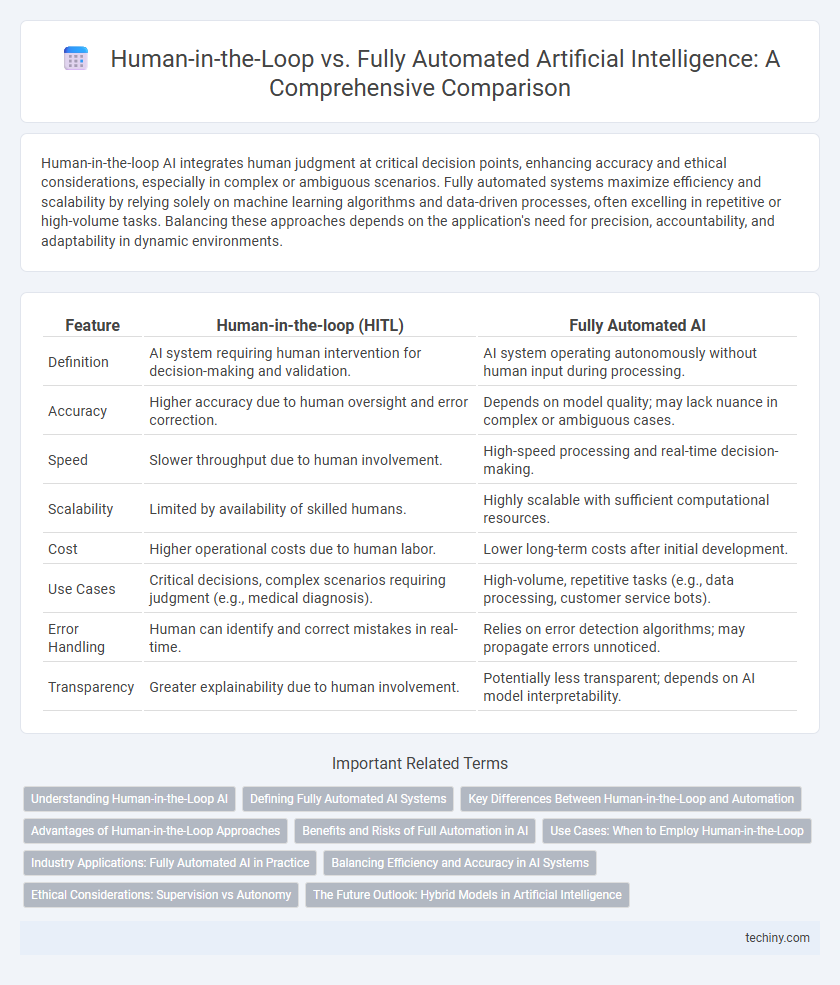Human-in-the-loop AI integrates human judgment at critical decision points, enhancing accuracy and ethical considerations, especially in complex or ambiguous scenarios. Fully automated systems maximize efficiency and scalability by relying solely on machine learning algorithms and data-driven processes, often excelling in repetitive or high-volume tasks. Balancing these approaches depends on the application's need for precision, accountability, and adaptability in dynamic environments.
Table of Comparison
| Feature | Human-in-the-loop (HITL) | Fully Automated AI |
|---|---|---|
| Definition | AI system requiring human intervention for decision-making and validation. | AI system operating autonomously without human input during processing. |
| Accuracy | Higher accuracy due to human oversight and error correction. | Depends on model quality; may lack nuance in complex or ambiguous cases. |
| Speed | Slower throughput due to human involvement. | High-speed processing and real-time decision-making. |
| Scalability | Limited by availability of skilled humans. | Highly scalable with sufficient computational resources. |
| Cost | Higher operational costs due to human labor. | Lower long-term costs after initial development. |
| Use Cases | Critical decisions, complex scenarios requiring judgment (e.g., medical diagnosis). | High-volume, repetitive tasks (e.g., data processing, customer service bots). |
| Error Handling | Human can identify and correct mistakes in real-time. | Relies on error detection algorithms; may propagate errors unnoticed. |
| Transparency | Greater explainability due to human involvement. | Potentially less transparent; depends on AI model interpretability. |
Understanding Human-in-the-Loop AI
Human-in-the-loop AI integrates human judgment directly into the machine learning process, enhancing decision accuracy and ethical considerations by allowing continuous human oversight. This approach is indispensable in high-stakes fields like healthcare and autonomous driving, where nuanced human insight complements algorithmic predictions. By contrast, fully automated systems operate without human intervention, potentially increasing efficiency but risking errors in complex, ambiguous scenarios where human expertise is crucial.
Defining Fully Automated AI Systems
Fully automated AI systems operate independently without continuous human intervention, relying on advanced algorithms and machine learning models to process data and make decisions. These systems excel in environments requiring high-speed analysis and consistent output, such as real-time fraud detection and autonomous vehicles. The key advantage lies in scalability and efficiency, although they may lack adaptive judgment in complex, ambiguous scenarios where human insight remains critical.
Key Differences Between Human-in-the-Loop and Automation
Human-in-the-loop (HITL) integrates human judgment into AI workflows, enhancing accuracy in complex decision-making tasks where contextual understanding is critical. Fully automated systems rely solely on algorithms and machine learning models to execute processes without human intervention, optimizing speed and scalability. Key differences include HITL's ability to manage ambiguity through human expertise, while full automation emphasizes efficiency and consistency in repetitive or data-intensive operations.
Advantages of Human-in-the-Loop Approaches
Human-in-the-loop (HITL) approaches in artificial intelligence enhance system accuracy by incorporating human judgment to validate and correct machine outputs, reducing errors in complex or ambiguous scenarios. These methods improve adaptability and ethical oversight by allowing humans to intervene in decision-making processes, ensuring transparency and accountability. HITL systems also facilitate continuous learning and model refinement through iterative feedback, leading to more reliable and context-aware AI performance.
Benefits and Risks of Full Automation in AI
Full automation in AI offers increased efficiency, scalability, and reduced human error by enabling systems to operate independently without constant oversight. However, risks include potential loss of control, ethical concerns, and challenges in handling unexpected scenarios due to lack of human judgment. Balancing automation with human-in-the-loop approaches ensures critical decisions benefit from human intuition while leveraging AI's computational power.
Use Cases: When to Employ Human-in-the-Loop
Human-in-the-loop (HITL) AI systems are essential in high-stakes industries like healthcare, finance, and legal sectors where decision accuracy and ethical considerations require human judgment alongside machine learning. HITL is favored in scenarios involving complex data interpretation, ambiguous inputs, or evolving regulations that automated systems alone may misinterpret. Fully automated AI excels in repetitive, large-scale data processing tasks with clear rules, but human-in-the-loop ensures accountability and adaptability in critical, nuanced applications.
Industry Applications: Fully Automated AI in Practice
Fully automated AI systems revolutionize industry applications by enabling real-time data processing and decision-making without human intervention, significantly increasing efficiency and scalability. In manufacturing, predictive maintenance powered by fully automated AI reduces downtime and operational costs by anticipating equipment failures. Autonomous supply chain management optimizes logistics through continuous data analysis, enhancing responsiveness and resource allocation across complex networks.
Balancing Efficiency and Accuracy in AI Systems
Human-in-the-loop AI systems enhance accuracy by integrating human judgment with machine learning, reducing errors in complex decision-making tasks. Fully automated AI offers unparalleled efficiency, processing large-scale data rapidly but may sacrifice nuanced understanding and contextual sensitivity. Balancing these approaches ensures optimal performance, leveraging human insight to refine AI outputs while maintaining high throughput in operational environments.
Ethical Considerations: Supervision vs Autonomy
Human-in-the-loop systems ensure ethical oversight by maintaining human supervision over AI decision-making, reducing risks of biased or harmful outcomes. Fully automated AI offers autonomy and efficiency but raises concerns about accountability and transparency in ethical dilemmas. Balancing supervision with autonomy is crucial to uphold ethical standards in AI deployment.
The Future Outlook: Hybrid Models in Artificial Intelligence
Hybrid models in artificial intelligence combine human expertise with automated systems to enhance decision-making accuracy and adaptability. These models leverage machine learning algorithms alongside human judgment, ensuring ethical considerations and contextual understanding are integrated into AI processes. The future outlook emphasizes scalable hybrid frameworks that optimize efficiency while maintaining accountability and reducing risks in complex AI applications.
Human-in-the-loop vs Fully Automated Infographic

 techiny.com
techiny.com